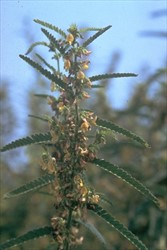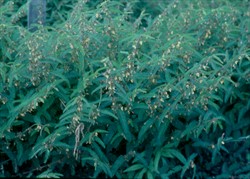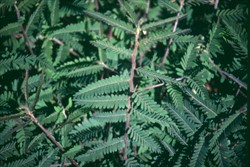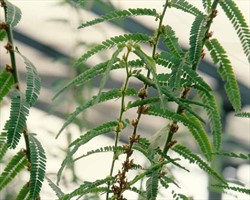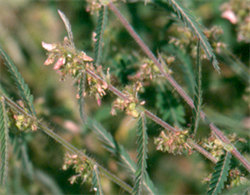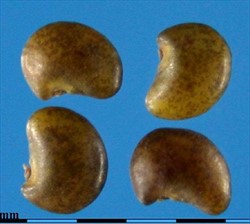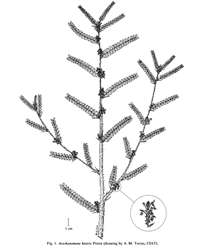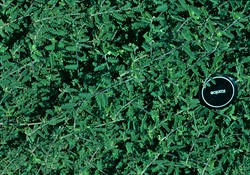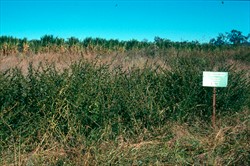Tropical Forages
Aeschynomene histrix Poir.
Subordinate taxa:
Aeschynomene histrix Poir. var. densiflora (Benth.) Rudd
Aeschynomene histrix Poir. var. histrix
Aeschynomene histrix Poir. var. incana (Vogel) Benth.
Note: The genus, Aeschynomene, is separated into two sections: Aeschynomene and Ochopodium. The former encompasses predominantly species from humid environments, such as Aeschynomene americana, Aeschynomene indica and Aeschynomene villosa, while the latter includes a number of dryland species, such as Aeschynomene brasiliana, Aeschynomene falcata and Aeschynomene histrix.
Aeschynomene histrix: Secula hystrix (Poir.) Small
var. densiflora: Basionym: Aeschynomene densiflora Benth.
var. incana: Basionym: Aeschynomene incana Vogel
Family: Fabaceae (alt. Leguminosae) subfamily: Faboideae tribe: Dalbergieae.
Prostrate to semi-erect or erect tap-rooted perennial herb or sub-shrub, 10‒80 cm tall, and 75‒160 cm diameter; stem moderately pubescent and hispid with yellowish glandular hairs 2‒4 mm long. Leaves pinnate, 16‒30-foliolate, leaflets oblong-elliptic, rarely obovate, 4‒12 mm long, 1.5‒4 mm wide, upper surface pubescent to glabrous, lower surface pubescent. Inflorescence racemose, axillary, comprising 4‒15 yellow, orange or white flowers, with standard 5‒7 mm long. Pod glabrous to moderately pubescent, comprising 2 (rarely 3) fertile segments, each 2‒2.5 (rarely 3) mm long, and 2.5 mm wide. Seeds black, 1.5‒2 mm long, 1‒1.5 mm wide; 420,000‒910,000 seeds/kg.
var. densiflora: stems suberect; leaflets 7‒12 mm long, 2‒4 mm wide; stipules 6‒15 mm long, (1‒) 2‒3 mm wide at base; articles of fruit 2‒2.5 mm in diameter (or, rarely, 3 mm long); flowers 5‒7 mm long.
var. histrix: stems usually prostrate; leaflets 4‒6 (‒8) mm long, 1.5‒3 mm wide; stipules 4‒5 mm long, about 1 mm wide at base; articles of fruit glabrous to moderately crisp-puberulent; stems and leaves moderately pubescent, often glabrate; bracteoles about as long as calyx; flowers 5‒6 mm. long.
var. incana: stems usually prostrate; leaflets 4‒6 (‒8) mm long, 1.5‒3 mm wide; stipules 4‒5 mm long, about 1 mm wide at base; articles of fruit pubescent, the hairs usually appressed; stems and leaves generally canescent; bracteoles about half as long as calyx; flowers 6‒7 mm. long.
Native:
Northern America: Mexico (Colima, Jalisco, Mexico, Sinaloa)
Central America: Belize, Costa Rica, Guatemala, Honduras, Nicaragua
South America: Argentina, Brazil, Bolivia, Colombia, French Guiana, Guyana, Paraguay, Peru, Suriname, Uruguay, Venezuela
Naturalized:
Northern America: USA (Florida)
Cultivated:
Africa: Benin, Nigeria
Forage
Although not extensively evaluated, Aeschynomene histrix appears to have potential to contribute to both livestock-forage and improved fallow systems in the tropics. May have potential in permanent pastures, but needs further evaluation of persistence.
Environment
Can act as a fast-decomposing green manure, although establishment may be slow, and may produce insufficient bulk for this purpose. Can act as a trap crop for the parasitic plant, Striga hermonthica in cropping systems although there is genetic variation in the ability to initiate suicidal germination. In West Africa, innovative farmers are using Aeschynomene histrix or Mucuna pruriens intercropped with maize or yam in rotation.
Occurs in savannah, grassland, pine woods, rocky hillsides and waste places.
Soil requirements
Collected mainly in sandy, acid and low-fertility soils, although also in sandy loams and clays. Adapted to acid to neutral, well drained, low-fertility soils such as ultisols and oxisols.
Moisture
Occurs naturally in areas with annual rainfall mostly between 1,000 and 1,500 mm, the extremes being about 800 mm in Argentina and 2,760 mm in PanamAeschynomene Moderate drought tolerance. No record of tolerance of flooding or waterlogging.
Temperature
Germplasm collections are from about 15º N in Guatemala to about 23º S in Paraguay, at altitudes to about 1,400 m asl. Aeschynomene histrix var. incana extends to about 34º S in Uruguay and 31º S in Argentina, and to 31º N in FloridAeschynomene This represents a range in average annual temperatures from about 17 to 26 ºC.
Light
No information available.
Reproductive development
Aeschynomene histrix is primarily a short day plant. There is considerable variation in critical photoperiod within the species.
Defoliation
Plants are sensitive to frequent cutting. It can be expected that the more prostrate types are better adapted to grazing than erect types.
Fire
No information available but in their native savannah habitat, tap-rooted populations are able to withstand fires.
Guidelines for establishment and management of sown forages.
Establishment
Mechanical scarification of hand-harvested seed may be necessary to overcome high levels of hardseededness. Machine harvested seed is scarified by the threshing process. Aeschynomene histrix appears to be somewhat promiscuous, but may nodulate more effectively with Aeschynomene inoculum CB 2312.
Fertilizer
No information available.
Compatibility (with other species)
Competes successfully with weeds in a seasonally dry environment. Has not been successful in more humid environments, possibly due to higher grass competition.
Companion species
Grasses: Bothriochloa pertusa, Urochloa mosambicensis.
Legumes: Chamaecrista rotundifolia, Stylosanthes guianensis var. guianensis, , .
Pests and diseases
Anthracnose, caused by the fungus Colletotrichum gloeosporioides, is the most important disease in Aeschynomene histrix. Isolates of the pathogen from Aeschynomene spp. can infect other legumes. More prostrate ecotypes are generally more affected by Rhizoctonia foliar blight, and semi-erect to erect ecotypes by Fusarium wilt. Some ecotypes appear susceptible to legume little-leaf phytoplasmAeschynomene Flowers and developing pods may be attacked by heliothis (Helicoverpa armigera) larvae.
Ability to spread
Aeschynomene histrix spreads by seed. However, many accessions are very late flowering and seed set may be interrupted by dry season or frost.
Weed potential
Vigorous growth, high seed production, high levels of hard seed, and relative ease of establishment suggest some weediness potential in certain environments.
Nutritive value
Average leaf:stem ratios vary from 0.5:1 to 1.1:1, with individual ecotype extremes ranging from 0.3:1 to 1.9:1 depending on age of growth. CP levels vary from 13 to 28% in leaf, and from 9 to 15% in stem. IVDMD of leaf averages 53‒66% (extremes 32‒82%) and of stem, 30‒40% (extremes 23‒45%). P and Ca levels in 4-wk-old plants: 0.66% and 0.74%, respectively.
Palatability/acceptability
As with many tropical legumes, stock acceptance of Aeschynomene histrix improves with exposure to the species, to the point where it is readily eaten.
Toxicity
No information available.
Dry matter
In a set of more tropical selections, 5 growth habit groups were identified: (1) semi-erect, low growing; (2) prostrate, open; (3) decumbent, dense; (4) decumbent or semi-erect, few branches, thick stems, open; (5) semi-erect to erect, many branches, dense. Annual DM yields vary markedly with ecotype from <2 to 17 t/ha, but are mostly 2‒8 t/ha.
Animal production
No information available.
2n = 20. Aeschynomene species are mostly self-fertile.
Hand harvested seed yields average about 90 kg/ha, and more than 200 kg/ha in some accessions.
No information available.
- Good DM yields.
- Adaptation to acid and low-fertility soils.
- Potential as a Striga trap crop.
- Susceptibility to anthracnose.
- Sensitivity to frequent cutting.
Bielig, L.M. (1997) Chromosome numbers in the forage legume genus, Aeschynomene L. Sabrao Journal of Breeding and Genetics 29:33–39.
Maliki, R., Sinsin, B., Floquet, A., Cornet, D. and Lançon, J. (2017) Sedentary yam-based cropping systems in West Africa: Benefits of the use of herbaceous cover-crop legumes and rotation—lessons and challenges. Agroecology and Sustainable Food Systems 41(5):450–486. doi.org/10.1080/21683565.2017.1279252
Merkel, U., Peters, M., Tarawali, S.A., Schultze-Kraft, R. and Berner, D.K. (2000) Characterization of a collection of Aeschynomene histrix in subhumid Nigeria. The Journal of Agricultural Science 134:293–304. doi.org/10.1017/S0021859699007546
Rudd, V.E. (1955) The American species of Aeschynomene. Contributions from the United States National Herbarium 32:1–172. hdl.handle.net/10088/27083
None released.
The following three elite accessions have been selected in studies in south-west Nigeria based on agronomic performance, forage quality, seed production and ability to suppress Striga hermonthica.
CIAT 9690 (ILRI 12463, IRFL-2891, CPI 93599, ILCA-00149, UF-312) Origin Mato Grosso, Brazil (11.6º S, 200 m asl, c. 1,500 mm/yr). This accession was also amongst the best in limited testing in northern Australia.
CIAT 18539 (BRA 003948) Origin Mato Grosso, Brazil (15.1º S, 160 m asl, c. 1,700 mm/yr).
CIAT 18974 Origin Bolívar, Venezuela (7.4º N, 190 m asl, 1,270 mm/yr).
The following seven accessions were identified as being comparable to those above in the same Nigerian study but did not have the capacity to induce suicidal germination of striga seed to the same degree. These accessions are worthy of further evaluation where striga does not occur.
CIAT 7884, CIAT 8262 (BRA 001741), CIAT 8581 (ILCA 12135), CIAT 8904 (BRA 002691), CIAT 8907 (BRA 002739), CIAT 8911 (BRA 002801), CIAT 8943 (BRA 003123).
